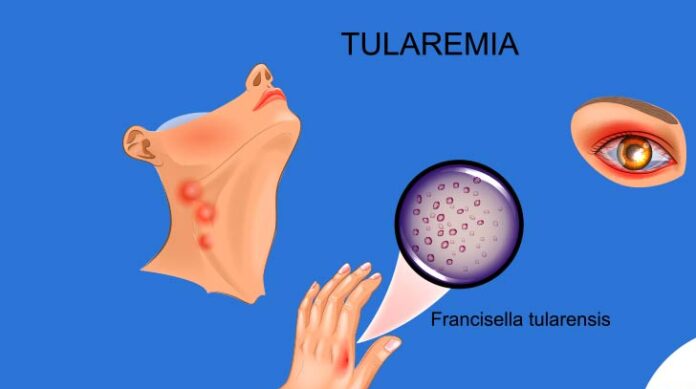Tularemia, also known as rabbit fever or deer fly fever, is a rare infectious disease caused by the bacterium Francisella tularensis. It primarily affects animals, especially rodents, rabbits, and hares, but can also infect humans. It is highly infectious and can be transmitted through various routes, including insect bites, contact with infected animals, ingestion of contaminated food or water, and inhalation of contaminated dust.
Symptoms
The symptoms can vary depending on how the bacteria enter the body. There are several forms of tularemia, each with distinct symptoms:
- Ulceroglandular Tularemia: The most common form.
- Skin ulcer at the site of infection
- Swollen and painful lymph glands
- Fever
- Chills
- Headache
- Exhaustion
- Glandular Tularemia: Similar to ulceroglandular but without the skin ulcer.
- Swollen lymph nodes
- Fever
- Chills
- Headache
- Oculoglandular Tularemia: From infection through the eye.
- Eye pain
- Redness and swelling of the eyes
- Ulcers on the inside of the eyelid
- Swollen lymph glands
- Oropharyngeal Tularemia: From eating or drinking contaminated food or water.
- Sore throat
- Mouth ulcers
- Tonsillitis
- Swollen lymph glands in the neck
- Fever
- Pneumonic Tularemia: The most serious form, from inhalation of bacteria.
- Cough
- Chest pain
- Difficulty breathing
- High fever
- Typhoidal Tularemia: A rare and severe form that can involve multiple organs.
- High fever
- Exhaustion
- Vomiting and diarrhea
- Enlargement of the spleen and liver
Causes
Tularemia is caused by the bacterium Francisella tularensis. The bacteria can infect humans through:
- Insect bites: Particularly from ticks and deer flies.
- Contact with infected animals: Handling or skinning infected animals, especially rabbits and rodents.
- Inhalation: Breathing in dust or aerosols contaminated with the bacteria.
- Ingestion: Consuming contaminated food or water.
Treatment
Early diagnosis and treatment are crucial for tularemia. The main treatment options include:
- Antibiotics: Effective antibiotics include streptomycin, gentamicin, doxycycline, and ciprofloxacin. Streptomycin and gentamicin are typically the first choices.
- Supportive Care: Depending on the severity, hospitalization may be required for intravenous antibiotics, fluids, and supportive care.
Prevention
Preventing tularemia involves reducing the risk of exposure to the bacteria. Key preventive measures include:
- Insect Protection: Use insect repellent, wear long sleeves and pants, and check for ticks after spending time in tick-infested areas.
- Avoiding Contact with Wild Animals: Do not handle sick or dead animals. Use gloves when handling animals, especially when skinning or dressing game.
- Safe Food and Water Practices: Avoid drinking untreated water and thoroughly cook food, especially game meat.
- Environmental Precautions: Be cautious when mowing or doing landscaping in areas where wildlife is prevalent, as this can stir up contaminated dust.
By understanding the transmission routes and taking appropriate precautions, the risk of contracting tularemia can be significantly reduced.
































